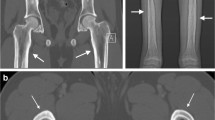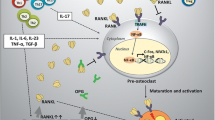Abstract
Immunohistochemical localization of osteopontin, a phosphorylated acidic glycoprotein, was compared in adult rat femur fixed in 4% paraformaldehyde at 4° C for 48 h and demineralized at 4° C in ethylenediaminetetraacetic acid (EDTA), modified Jenkin's solution, or 15% formic acid, until radiographs indicated demineralization was complete. Formic acid was also evaluated at room temperature. EDTA solution (15 days) resulted in intense staining of osteocytes, periosteal osteoclasts and osteoblastic cells in osteonal bone. Osteoblasts were negative in the periosteum. No megakaryocyte staining was present; however, occasional neutrophils in the bone marrow were non-specifically stained. Demineralization in modified Jenkin's solution (16 days) showed osteopontin localization in bone matrix, hypertrophic and articular chondrocytes, and osteocytes. In cortical bone, almost all cement lines demarcating osteons showed very dense labeling. In the bone marrow, occasional megakaryocytes were immunopositive and neutrophils were non-specifically stained. Jenkin's produced non-specific staining of skeletal muscle and connective tissue. Formic acid demineralization (14 days, 4° C) resulted in osteopontin expression in osteoblasts, osteocytes, osteoclast precursors, bone matrix, osteoid, cement lines, and chondrocytes; osteoclasts, although present in very low numbers, were also positive. More labeled osteoblasts could be identified compared to Jenkin's demineralization. Also more intense non-specific staining of the bone marrow neutrophils was obtained than with Jenkin's. Harsh, rapid demineralization with formic acid (4 days, room temperature) produced a loss in antigenicity demonstrated by a reduction in staining intensity not experienced with the 4° C protocol; however, osteopontin was still localized in bone matrix and hypertrophic zone chondrocytes. These results indicate that demineralization is compatible with retention of immunoreactive osteopontin in adult rat bone. Both EDTA and formic acid demineralization produce excellent immunostaining and are preferred over the modified Jenkin's solution to minimize background levels of non-specific staining.
Similar content being viewed by others
References
Athanasou NA, Quinn J, Heryet A, Woods CG, McGee JO'D (1987) Effect of decalcification agents on immunoreactivity of cellular antigens. J Clin Pathol 40:874–878
Bianco P, Silvestrini G, Termine JD, Bonucci E (1988) Immunohistochemical localization of osteonectin in developing human and calf bone using monoclonal antibodies. Calcif Tissue Int 43:155–161
Bianco P, Fisher LW, Young MF, Termine JD, Robey PG (1991) Expression of bone sialoprotein (BSP) in developing human tissues. Calcif Tissue Int 49:421–426
Butler WT (1989) The nature and significance of osteopontin. Conn Tissue Res 23:123–136
Chen J, Zhang Q, McCulloch CAG, Sodek J (1991) Immunohistochemical localization of bone sialoprotein in foetal porcine bone tissues: comparisons with secreted phosphoprotein 1 (SPP-1, osteopontin) and SPARC (osteonectin). Histochem J 23:281–289
Franzen A, Heinegard D (1985) In: Butler WT (ed) The chemistry and biology of mineralized tissues. Ebsco Media, Birmingham, Ala., pp 132–141
Gorter de Vries I, Quartier E, Van Steirteghem A, Boute P, Coomans D, Wisse E (1986) Characterization and immunocytochemical localization of dentine phosphoprotein in rat and bovine teeth. Arch Oral Biol 31:57–66
Kasugai S, Nagata T, Sodek J (1992) Temporal studies on the tissue compartmentalization of bone sialoprotein (BSP), osteopontin (OPN), and SPARC protein during bone formation in vitro. J Cell Physiol 152:467–477
Mark MP, Prince CW, Gay S, Austin RL, Bhown M, Finkelman RD, Butler WT (1987a) A comparative immunocytochemical study on the subcellular distributions of 44 kDa bone phosphoprotein and bone γ-carboxyglutamic acid (Gla)-containing protein in osteoblasts. J Bone Miner Res 2:337–346
Mark MP, Prince CW, Oosawa T, Gay S, Bronckers ALJJ, Butler WT (1987b) Immunohistochemical demonstration of a 44-kD phosphoprotein in developing rat bones. J Histochem Cytochem 35:707–715
Mark MP, Butler WT, Prince CW, Finkelman RD, Ruch J-V (1988) Developmental expression of 44-kDa bone phosphoprotein (osteopontin) and bone γ-carboxyglutamic acid (Gla)-containing protein (osteocalcin) in calcifying tissues of rat. Differentiation 37:123–136
Matthews JB (1982) Influence of decalcification on immunohistochemical staining of formalin-fixed paraffin-embedded tissue. J Clin Pathol 35:1392–1394
McKee MD, Nanci A, Landis WJ, Gotoh Y, Gerstenfeld LC, Glimcher MJ (1991) Effects of fixation and demineralization on the retention of bone phosphoprotein and other matrix components as evaluated by biochemical analyses and quantitative immunocytochemistry. J Bone Miner Res 6:937–945
Nomura S, Wills AJ, Edwards DR, Heath JK, Hogan BLM (1989) Expression of genes for non-collagenous proteins during embryonic bone formation. Conn Tissue Res 21:31–39
Reinholt FP, Hultenby K, Oldberg A, Heinegard D (1990) Osteopontin — a possible anchor of osteoclasts to bone. Proc Natl Acad Sci USA 87:4473–4475
Salonen J, Domenicucci C, Goldberg HA, Sodek J (1990) Immunohistochemical localization of SPARC (ostenectin) and denatured collagen and their relationship to remodelling in rat dental tissues. Arch Oral Biol 35:337–346
Vermeulen AHM, Vermeer C, Bosman FT (1989) Histochemical detection of osteocalcin in normal and pathological human bone. J Histochem Cytochem 37:1503–1508
Weinreb M, Shinar D, Rodan GA (1990) Different pattern of alkaline phosphatase, osteopontin, and osteocalcin expression in developing rat bone visualized by in situ hybridization. J Bone Miner Res 5:831–842
Yoon K, Buenaga R, Rodan GA (1987) Tissue specificity and developmental expression of rat osteopontin. Biochem Biophys Res Commun 148:1129–1136
Author information
Authors and Affiliations
Rights and permissions
About this article
Cite this article
Frank, J.D., Balena, R., Masarachia, P. et al. The effects of three different demineralization agents on osteopontin localization in adult rat bone using immunohistochemistry. Histochemistry 99, 295–301 (1993). https://doi.org/10.1007/BF00269102
Accepted:
Issue Date:
DOI: https://doi.org/10.1007/BF00269102




